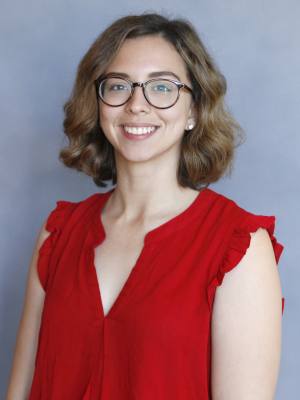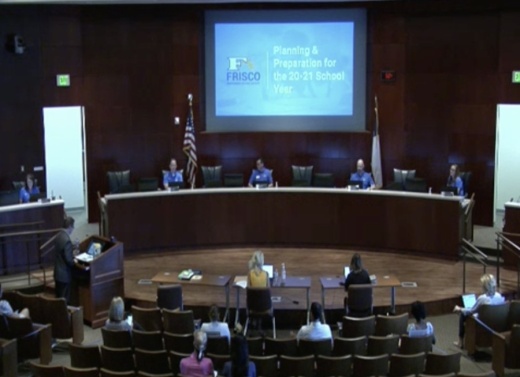District leaders presented these options to the board June 11 for what school could look come August 13, but Superintendent Mike Waldrip said FISD ultimately has little say for how school can be conducted in the upcoming school year.
“That direction will come from the state of Texas, from [the Texas Education Agency] and the governor,” Waldrip said. “That’s why we’re waiting, and we cannot put forth a firm plan.”
Texas school districts will receive guidance from the state next Tuesday, June 16, Waldrip said. One of the options presented at the June 11 meeting may be implemented if directed by the state, he said.
“We want nothing more than to start school as normal,” FISD Chief Academic Officer Wes Cunningham said at the meeting. “We have a duty to our community to plan for and prepare for a variety of likely contingencies for the upcoming school year.”
It is possible for multiple scenarios to play out over next school year based on COVID-19 infection rates and directives from government entities, according to a June 11 district release.
Three learning environments
The three presented options for the fall include face-to-face instruction; a hybrid of in-person and at-home learning with alternating schedule days; and 100% virtual instruction with at-home synchronous, real-time learning and asynchronous, independent learning.
The makeup of these learning environments is based on guidance from the TEA, the state of Texas, the Centers for Disease Control and Prevention and other governing agencies, Cunningham said.
“The traditional model is our desire,” he said. “That may come with some additional safety measures as dictated by the state.”
Some measures could include increasing the times of automatic restroom sinks, a switch to alcohol-based hand sanitizer and daily deep sanitation of campuses and buses, per the district release.
The hybrid model would only be used if FISD were directed to reduce the amount of students in schools by around 50% and to enforce a variety of social distancing requirements, Cunningham said.
The virtual model would be implemented if the district was directed to close a campus or a group of campuses due to a localized or widespread outbreak of COVID-19, Cunningham said. If implemented, this model would not mirror the e-learning model used in the spring, he added.
Virtual Academy
If the district operates in a face-to-face or hybrid model in the fall, Cunningham said there could be a possibility for some students to engage in virtual-only instruction at home in a program called Virtual Academy.
“This would allow students to opt out of face-to-face instruction or hybrid instruction based on criteria we receive from the state,” he said. “This could mean access to virtual instruction for most of our education offerings.”
Per the district release, some key aspects of Virtual Academy include a mix of prerecorded videos, real-time virtual lessons and regular morning meetings.
If FISD implements Virtual Academy, Cunningham said no teacher would be expected to be a virtual teacher while simultaneously operating as a normal classroom teacher.
Elementary-level implementation
Should the hybrid model be implemented at FISD elementary school, students would engage in virtual instruction at home on Mondays, said Mary Webb, FISD managing director of elementary instruction.
One group of students would then attend in-person classes on Tuesdays and Thursdays, and a second group would attend on Wednesdays and Fridays, she said.
Virtual learning on Mondays would involve synchronous and asynchronous learning for students. The other half of the day would allow for teacher collaboration and learning, Webb said.
“This takes a lot of work,” she said. “We learned that in the spring, and so we needed to carve out some time for some collaboration for teachers.”
For 100% virtual learning, Mondays would once again be half-days, Webb said. Tuesday through Friday would involve synchronous and asynchronous learning with morning meetings and personalized learning opportunities, she said.
Webb said a parent’s role would change slightly if a Virtual Academy option is available.
“It’s going to be a parent as a learning coach,” she said, "because we’re going to really need a strong collaboration with the parent in order to pull this off successfully for the student.”
Learning in the Virtual Academy would involve the same half-day setup on Mondays and a synchronous and asynchronous approach Tuesday through Friday, Webb said.
Bilingual options would be available for students in both virtual situations, Webb said.
Secondary-level implementation
The hybrid model at FISD’s middle and high schools will have groupings much like those at the elementary level when attending school in-person, Cunningham said.
Once more, Mondays will be for virtual asynchronous and synchronous learning at home for a half-day, he said. The other half of the day will be used for teacher collaboration.
Middle and high school students would attend school in person Tuesday through Friday in two groups, Cunningham said. Group 1 would attend school on Tuesdays and Thursdays, and Group 2 would attend school on Wednesdays and Fridays.
Cunningham said the eight class periods middle and high school students typically attend would be divided between the two days they attend in-person classes.
For the 100% virtual option, students would do a half-day of virtual learning on Mondays. Students would engage in synchronous, asynchronous and personalized learning for the remainder of the week, Cunningham said.
With Virtual Academy, Cunningham said half-days of virtual learning would continue on Mondays, and synchronous learning would occur Tuesday through Friday.
The district will have to wait on guidance from governmental entities before executing extracurricular and co-curricular activities at the secondary level, he said.





